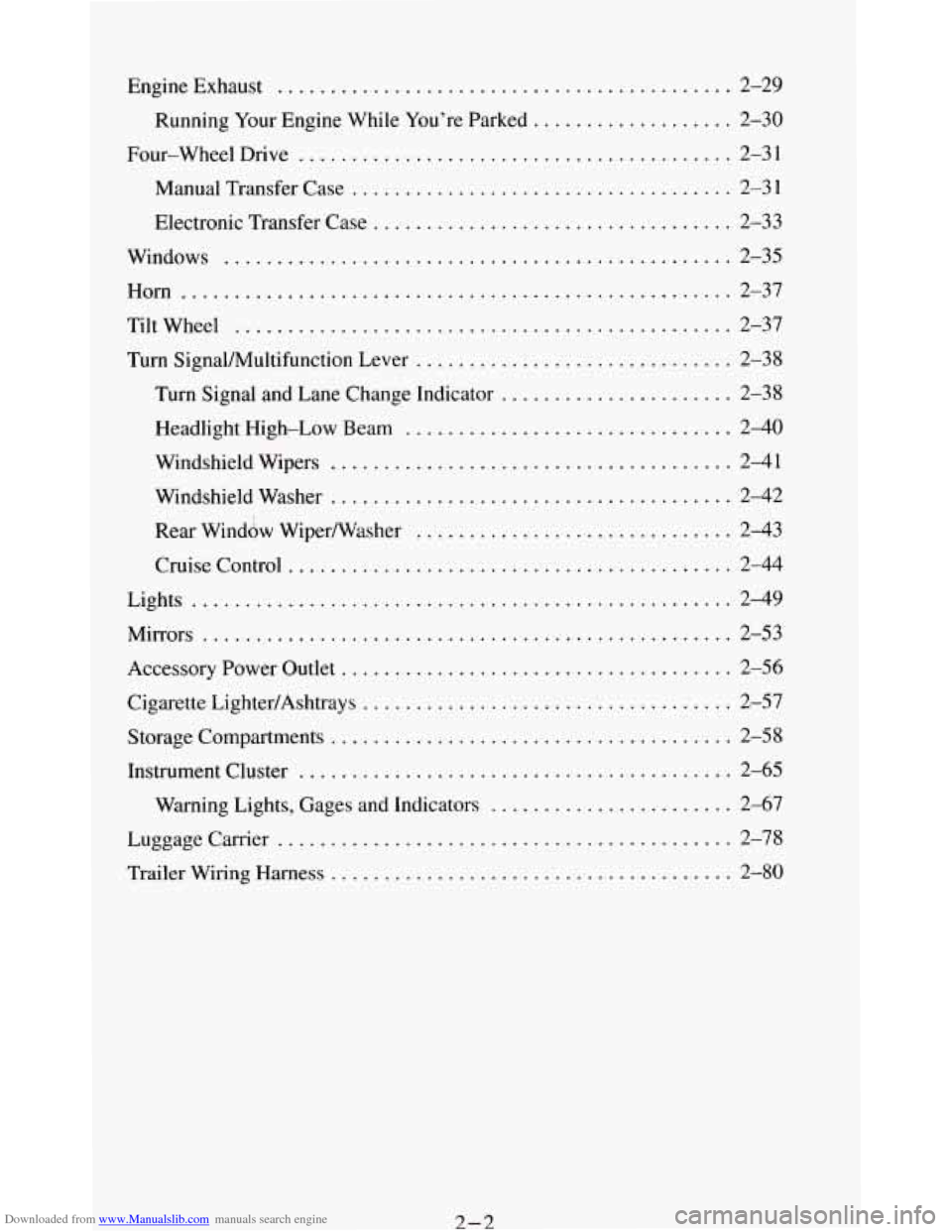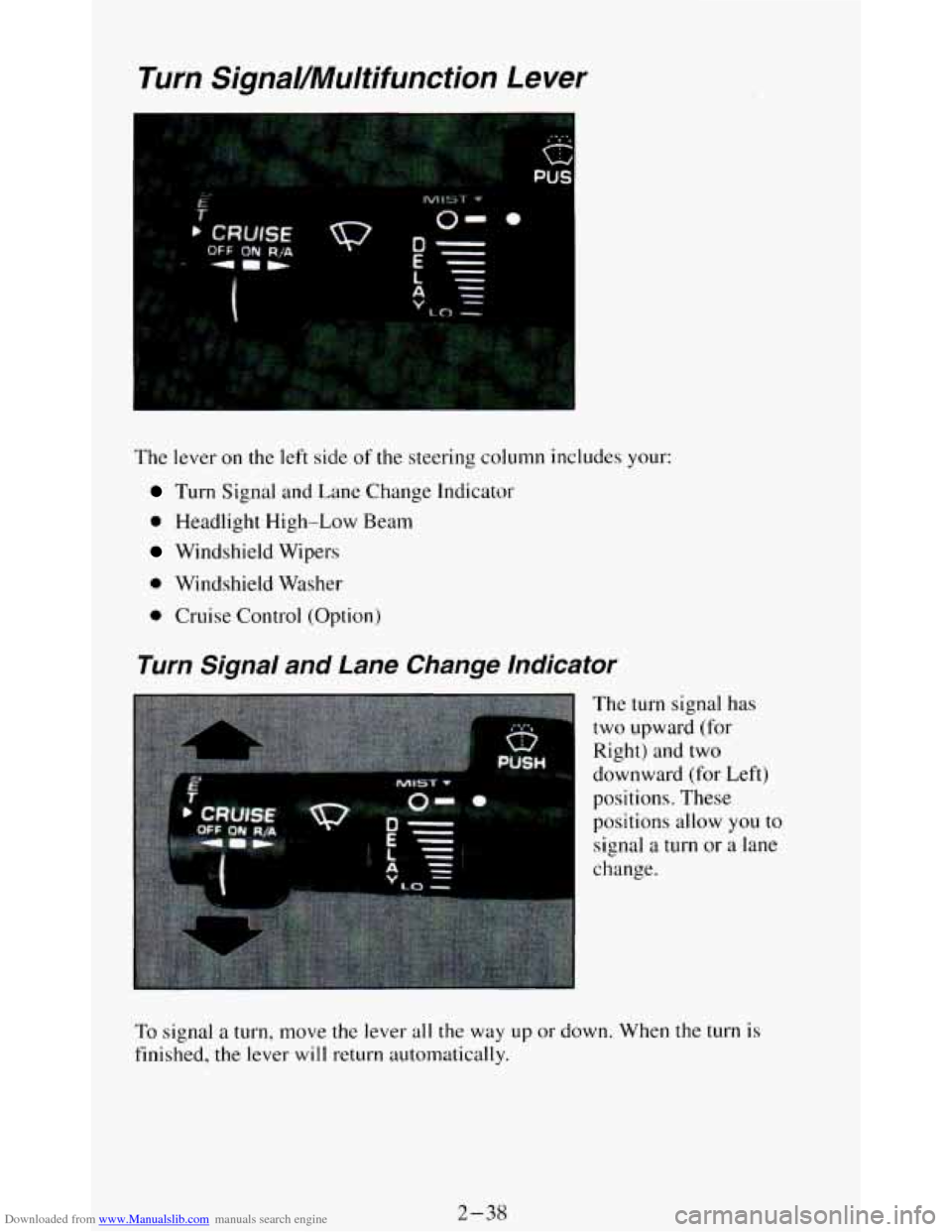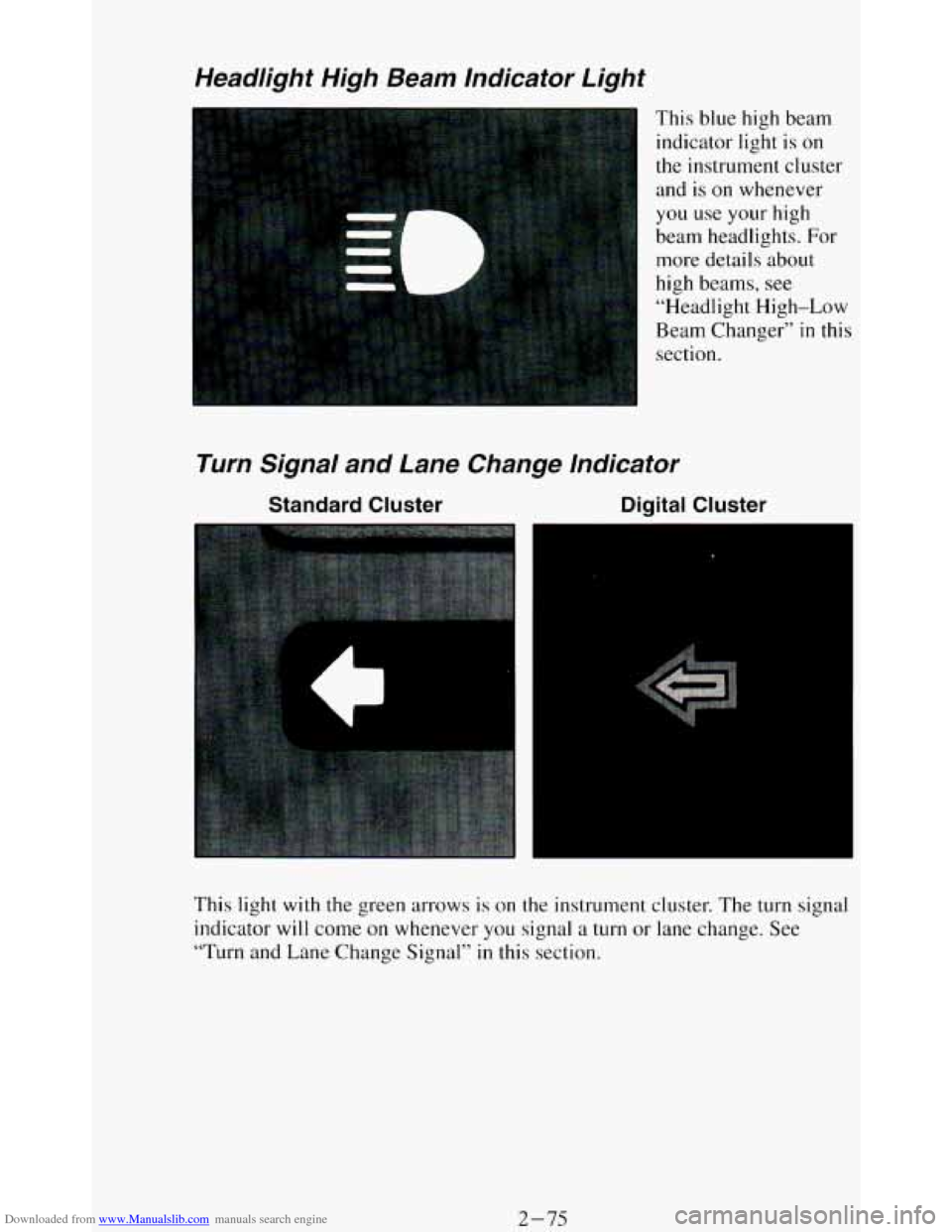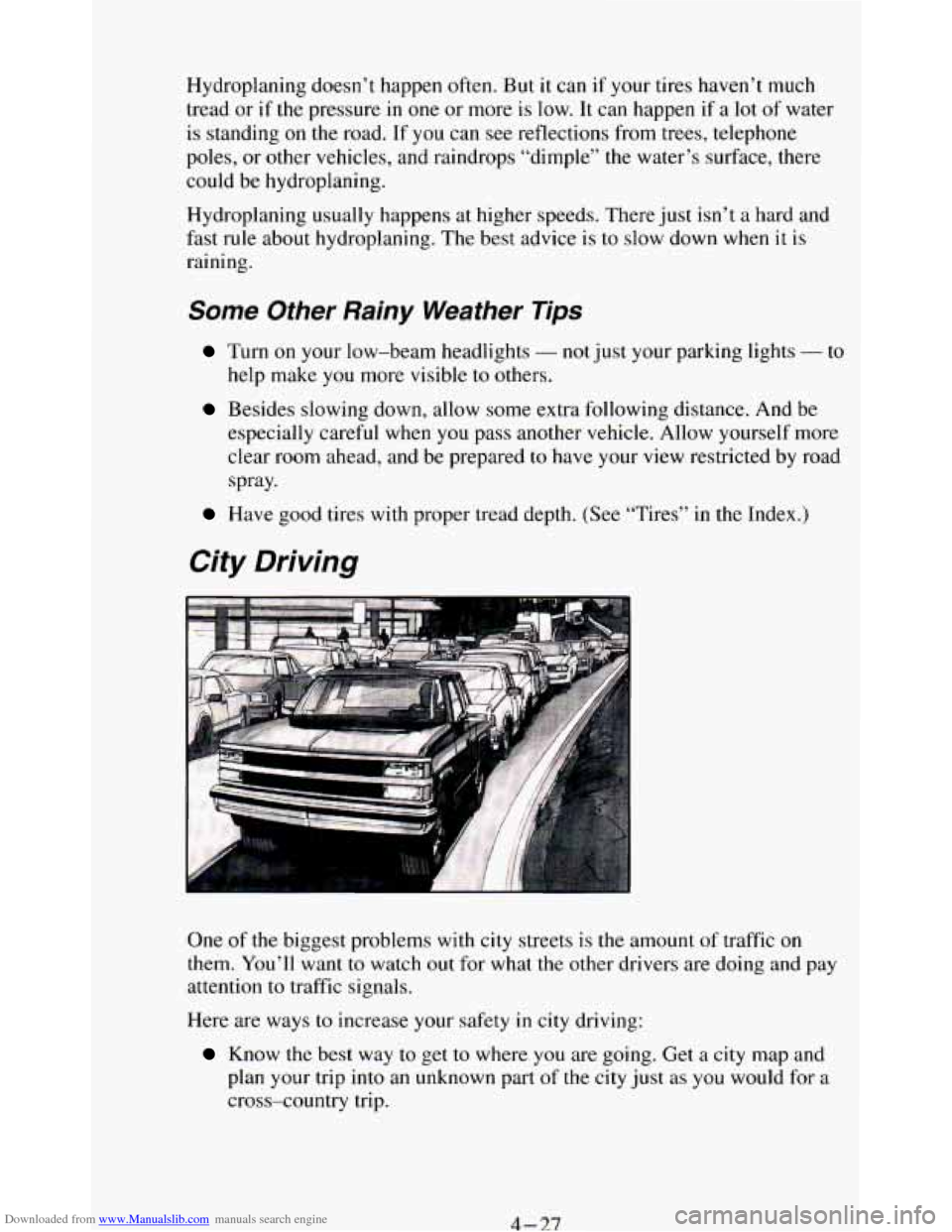1994 CHEVROLET BLAZER low beam
[x] Cancel search: low beamPage 56 of 348

Downloaded from www.Manualslib.com manuals search engine EngineExhaust ........................................... 2-29
Running Your Engine While You’re Parked
................... 2-30
Four-WheelDrive
......................................... 2-31
Manual Transfer Case
.................................... 2-31
Electronic Transfer Case
.................................. 2-33
Windows
................................................ 2-35
Horn
.................................................... 2-37
Tiltwheel
............................................... 2-37
Turn Signal/Multifunction Lever
.............................. 2-38
Turn Signal and Lane Change Indicator
...................... 2-38
Headlight High-Low Beam
............................... 2-40
Windshield Wipers
...................................... 2-41
Windshield Washer
...................................... 2-42
Rear Window Wiper/Washer
.............................. 2-43
Cruise Control
.......................................... 2-44
Lights
................................................. 2-49
Mirrors
.................................................. 2-53
Accessory Power Outlet
..................................... 2-56
Cigarette LightedAshtrays
................................... 2-57
Storage Compartments
...................................... 2-58
Instrument Cluster ......................................... 2-65
Warning Lights. Gages
and Indicators ....................... 2-67
Luggagecarrier
........................................... 2-78
Trailer Wiring Harness
...................................... 2-80
2-2
Page 92 of 348

Downloaded from www.Manualslib.com manuals search engine Turn SignaVMultifunction Lever
The lever on the left side of the steering column includes your:
Turn Signal and Lane Change Indicator
0 Headlight High-Low Beam
Windshield Wipers
0 Windshield Washer
0 Cruise Control (Option)
Turn Signal and Lane Change Indicator
The turn sign2 11 has
two upward (for
Right) and two
downward (for Left)
positions. These
positions allow you to
signal
a turn or a lane
change.
To signal a turn, move the lever all the way up or down. When the turn is
finished,
the lever will return automatically.
2-38
Page 94 of 348

Downloaded from www.Manualslib.com manuals search engine Operation of Lights
Although your vehicle's lighting system (headlights, parking lig\
hts, fog
lamps, side marker lights and taillights) meets
all applicable federal lighting
requirements, certain states and provinces may apply their own lighting
regulations that may require special
attention before you operate these
lights.
For example, some jurisdictions may require that you operate your fog
lamps
only when your lower beam headlights are also on, or that headlights
be turned
on whenever you must use your windshield wipers. In addition,
most jurisdictions prohibit driving solely with parking lights, especially at
dawn or dusk. It is recommended that
you check with your own state or
provincial highway authority for applicable lighting regulations.
Headlight High-Low Beam
To change the
headlights from low
beam to high or high
to
low, pull the turn
signal lever all the
way toward you. Then
release
it.
When the high beams
are
on, this blue
indicator light on the
instrument panel also
will be on.
2-40
Page 104 of 348

Downloaded from www.Manualslib.com manuals search engine Turn the switch to the left to dim your instrument panel and transfer case
indicator lights.
You can switch your headlights from high to low beam by pulling on the
multifunction lever.
A circuit breaker protects your headlights. If you have an electrical
overload, your headlights will flicker
on and off. Have your headlight
wiring checked right away
if this happens.
Fog Lamps (Option)
The fog lamp switch is on the instrument panel under the headlight switch.
Press the right side of
the switch
to turn the
fog lamps
on, and the
left side of the switch
to turn them off. A
light will glow in the
right side
of the
switch
when they are
on.
Remember, fog lamps alone
will not give off as much light as your
headlights.
Never
use your fog lamps in the dark without turning on your headlights.
Fog lamps will
go off whenever your high beam headlights come on. When
the high beams
go off, the fog lamps will come on again.
2-50
Page 127 of 348

Downloaded from www.Manualslib.com manuals search engine Indicator Lights
Indicator lights go on when you use your turn signals, change from low
beam headlights to high beams, or when you use
your hazard flashers. The
next few pages will also
tell you about the indicator lights on your vehicle
and help you locate them.
Charging System Light
The charging system
light is
on your
instrument cluster and
will come
on briefly
when
you turn on the
ignition, but the
engine is
not running,
as a check to show
you it
is working.
It should go out once the engine is running. If it stays on, or comes on while
you are driving, you may have a problem with the charging system. It could
indicate that you have problems with
a generator drive belt, or another
electrical problem. Have
it checked right away. Driving while this light is on
could drain your battery.
If
you must drive a short distance with the light on, be certain to turn off all
your accessories, such as the radio and air conditioner.
If you have the
standard cluster, this
Check Gages light
will come on briefly
when you are starting
the engine. If the light
comes
on and stays on
while you are driving,
check your various
gages to see
if they are
in the warning zones.
2-73
Page 129 of 348

Downloaded from www.Manualslib.com manuals search engine Headlight High Beam lndicator Light
This blue high beam
indicator light is
on
the instrument cluster
and is
on whenever
you use
your high
beam headlights. For
more details about
high beams, see
“Headlight High-Low
Beam Changer”
in this
section.
Turn Signal and Lane Change lndicator
Standard Cluster Digital Cluster
4
This light with the green arrows is on the instrument cluster. The turn signal
indicator will come on whenever
you signal a turn or lane change. See
“Turn and Lane Change Signal”
in this section.
2-75
Page 183 of 348

Downloaded from www.Manualslib.com manuals search engine Night Vision
No one can see as well at night as in the daytime. But as we get older these
differences increase. A 50-year-old driver may require at least twice as
much light to see the same thing at night as a 20-year-old.
What
you do in the daytime can also affect your night vision. For example,
if you spend the day in bright sunshine you are wise
to wear sunglasses.
Your eyes will have less trouble adjusting
to night. But if you’re driving,
don’t wear sunglasses at night. They may cut down on glare from
headlights, but they also make a
lot of things invisible.
You can be temporarily blinded by approaching lights. It can take a second
or two,
or even several seconds, for your eyes to readjust to the dark. When
you are faced with severe glare
(as from a driver who doesn’t lower the high
beams,
or a vehicle with misaimed headlights), slow down a little. Avoid
staring directly into the approaching lights.
Keep your windshield and all the glass
on your vehicle clean - inside and
out. Glare at night is made much worse by dirt on the glass. Even the inside
of the glass can build up a film caused by dust. Dirty glass makes lights
dazzle and flash more than
clean glass would, making the pupils of your
eyes contract repeatedly.
Remember that your headlights light up far less
of a roadway when you are
in a turn or curve. Keep your eyes moving; that way, it’s easier to pick out
dimly lighted objects. Just as your headlights should be checked regularly
for proper aim,
so should your eyes be examined regularly. Some drivers
suffer from night blindness
- the inability to see in dim light - and aren’t
even aware of it.
Driving in the Rain
Rain and wet roads can mean driving trouble. On a wet road you can’t stop,
accelerate or turn as well because your tire-to-road traction isn’t as good as
on dry roads. And, if your tires don’t have much tread left, you’ll get even
4 - 7.5
Page 185 of 348

Downloaded from www.Manualslib.com manuals search engine Hydroplaning doesn’t happen often. But it can if your tires haven’t much
tread or
if the pressure in one or more is low. It can happen if a lot of water
is standing on the road.
If you can see reflections from trees, telephone
poles, or other vehicles, and raindrops “dimple” the water’s
surface, there
could be hydroplaning.
Hydroplaning usually happens at higher speeds. There just isn’t a hard and
fast rule about hydroplaning. The best advice is to slow down when it
is
raining.
Some Other Rainy Weather Tips
Turn on your low-beam headlights - not just your parking lights - to
help make you more visible to others.
Besides slowing down, allow some extra following distance. And be
especially careful when you pass another vehicle. Allow yourself more
clear room ahead, and be prepared
to have your view restricted by road
spray.
Have good tires with proper tread depth. (See “Tires” in the Index.)
City Driving
x
One of the biggest problems with city streets is the amount of traffic on
them. You’ll want to watch out for what the other drivers are doing and pay
attention to traffic signals.
Here
are ways to increase your safety in city driving:
Know the best way to get to where you are going. Get a city map and
plan your trip into an unknown part
of the city just as you would for a
cross-country trip.
4-27